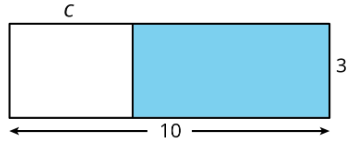33.2: Expressions with Exponents
- Page ID
- 40616
Lesson
Let's use the meaning of exponents to decide if equations are true.
Exercise \(\PageIndex{1}\): Which One Doesn't Belong: Twos
Which one doesn't belong?
\(2\cdot 2\cdot 2\cdot 2\)
\(16\)
\(2^{4}\)
\(4\cdot 2\)
Exercise \(\PageIndex{2}\): Is the Equation True?
Decide whether each equation is true or false, and explain how you know.
- \(2^{4}=2\cdot 4\)
- \(3+3+3+3+3=3^{5}\)
- \(5^{3}=5\cdot 5\cdot 5\)
- \(2^{3}=3^{2}\)
- \(16^{1}=8^{2}\)
- \(\frac{1}{2}\cdot\frac{1}{2}\cdot\frac{1}{2}\cdot\frac{1}{2}=4\cdot\frac{1}{2}\)
- \(\left(\frac{1}{2}\right)^{4}=\frac{1}{8}\)
- \(8^{2}=4^{3}\)
Exercise \(\PageIndex{3}\): What's Your Reason?
In each list, find expressions that are equivalent to each other and explain to your partner why they are equivalent. Your partner listens to your explanation. If you disagree, explain your reasoning until you agree. Switch roles for each list. (There may be more than two equivalent expressions in each list.)
-
- \(5\cdot 5\)
- \(2^{5}\)
- \(5^{2}\)
- \(2\cdot 5\)
-
- \(4^{3}\)
- \(3^{4}\)
- \(4\cdot 4\cdot 4\)
- \(4+4+4\)
-
- \(6+6+6\)
- \(6^{3}\)
- \(3^{6}\)
- \(3\cdot 6\)
-
- \(11^{5}\)
- \(11\cdot 11\cdot 11\cdot 11\cdot 11\)
- \(11\cdot 5\)
- \(5^{11}\)
-
- \(\frac{1}{5}\cdot\frac{1}{5}\cdot\frac{1}{5}\)
- \(\left(\frac{1}{5}\right)^{3}\)
- \(\frac{1}{15}\)
- \(\frac{1}{125}\)
-
- \(\left(\frac{5}{3}\right)^{2}\)
- \(\left(\frac{3}{5}\right)^{2}\)
- \(\frac{10}{6}\)
- \(\frac{25}{9}\)
Are you ready for more?
What is the last digit of \(3^{1,000}\)? Show or explain your reasoning.
Summary
When working with exponents, the bases don’t have to always be whole numbers. They can also be other kinds of numbers, like fractions, decimals, and even variables. For example, we can use exponents in each of the following ways:
\(\left(\frac{2}{3}\right)^{4}=\frac{2}{3}\cdot\frac{2}{3}\cdot\frac{2}{3}\cdot\frac{2}{3}\)
\((1.7)^{3}=(1.7)\cdot (1.7)\cdot (1.7)\)
\(x^{5}=x\cdot x\cdot x\cdot x\cdot x\)
Practice
Exercise \(\PageIndex{4}\)
Select all expressions that are equal to \(3\cdot 3\cdot 3\cdot 3\cdot 3\).
- \(3\cdot 5\)
- \(3^{5}\)
- \(3^{4}\cdot 3\)
- \(5\cdot 3\)
- \(5^{3}\)
Exercise \(\PageIndex{5}\)
Noah starts with 0 and then adds the number 5 four times. Diego starts with 1 and then multiplies by the number 5 four times. For each expression, decide whether it is equal to Noah’s result, Diego’s result, or neither.
- \(4\cdot 5\)
- \(4+5\)
- \(4^{5}\)
- \(5^{4}\)
Exercise \(\PageIndex{6}\)
Decide whether each equation is true or false, and explain how you know.
- \(9\cdot 9\cdot 3=3^{5}\)
- \(7+7+7=3+3+3+3+3+3+3\)
- \(\frac{1}{7}\cdot\frac{1}{7}\cdot\frac{1}{7}=\frac{3}{7}\)
- \(4^{1}=4\cdot 1\)
- \(6+6+6=6^{3}\)
Exercise \(\PageIndex{7}\)
- What is the area of a square with side lengths of \(\frac{3}{5}\) units?
- What is the side length of a square with area \(\frac{1}{16}\) square units?
- What is the volume of a cube with edge lengths of \(\frac{2}{3}\) units?
- What is the edge length of a cube with volume \(\frac{27}{64}\) cubic units?
Exercise \(\PageIndex{8}\)
Select all the expressions that represent the area of the shaded rectangle.

- \(3(10-c)\)
- \(3(c-10)\)
- \(10(c-3)\)
- \(10(3-c)\)
- \(30-3c\)
- \(30-10c\)
(From Unit 6.2.5)
Exercise \(\PageIndex{9}\)
A ticket at a movie theater costs $8.50. One night, the theater had $29,886 in ticket sales.
- Estimate about how many tickets the theater sold. Explain your reasoning.
- How many tickets did the theater sell? Explain your reasoning.
(From Unit 5.4.5)
Exercise \(\PageIndex{10}\)
A fence is being built around a rectangular garden that is \(8\frac{1}{2}\) feet by \(6\frac{1}{3}\) feet. Fencing comes in panels. Each panel is \(\frac{2}{3}\) of a foot wide. How many panels are needed? Explain or show your reasoning.
(From Unit 4.4.1)

